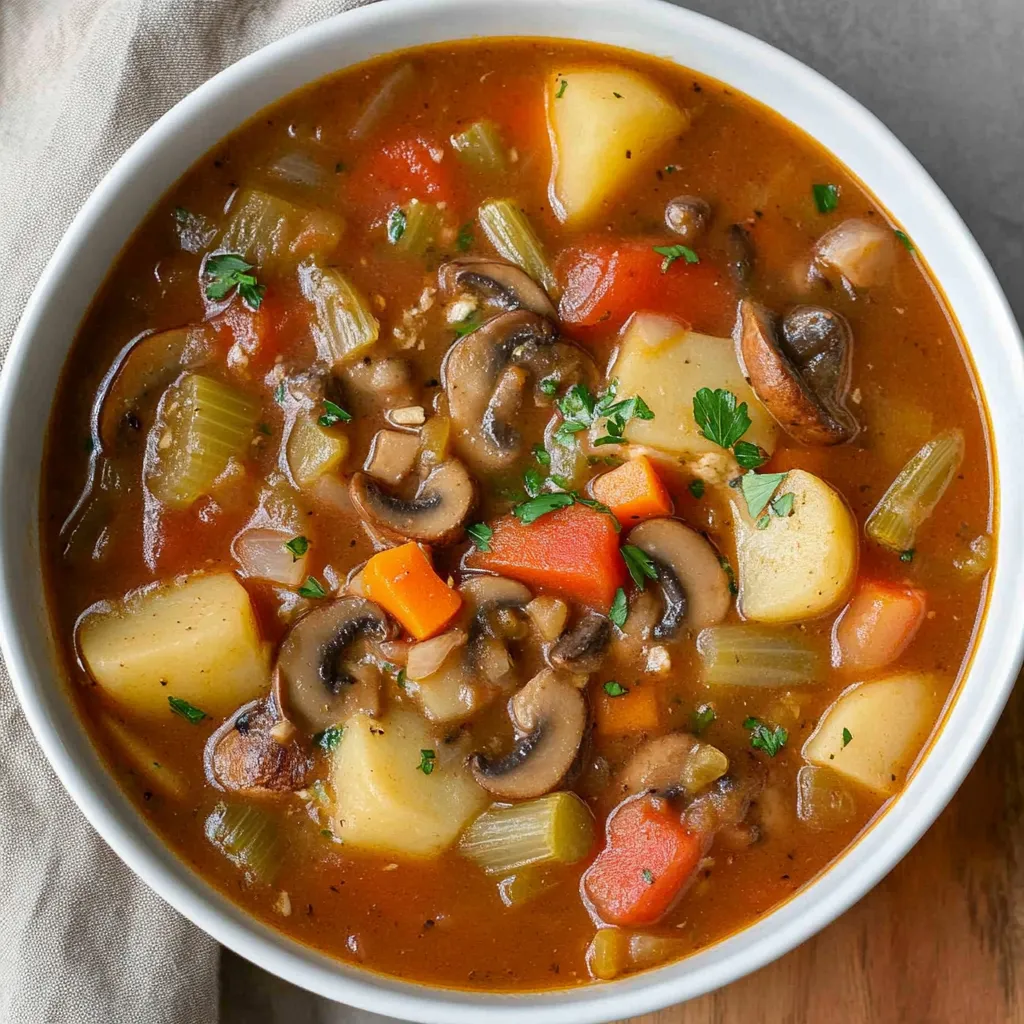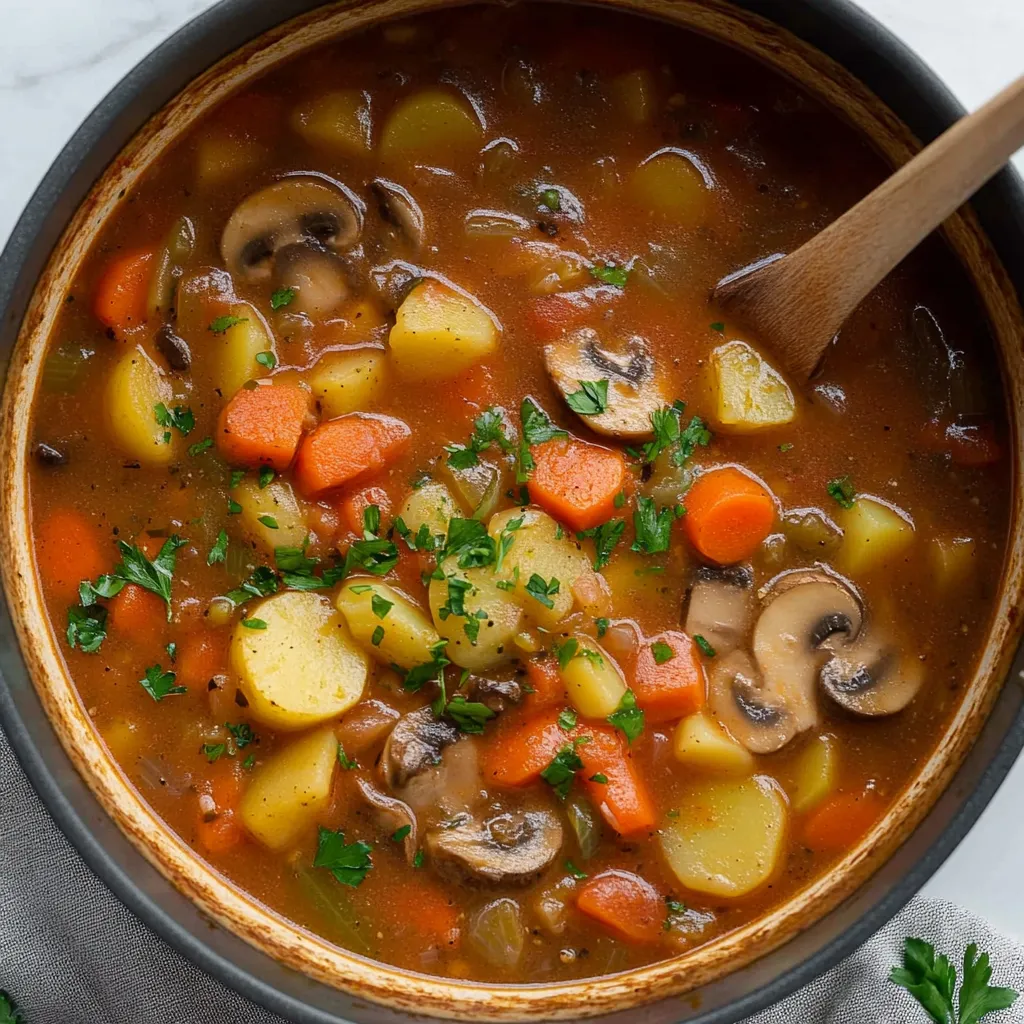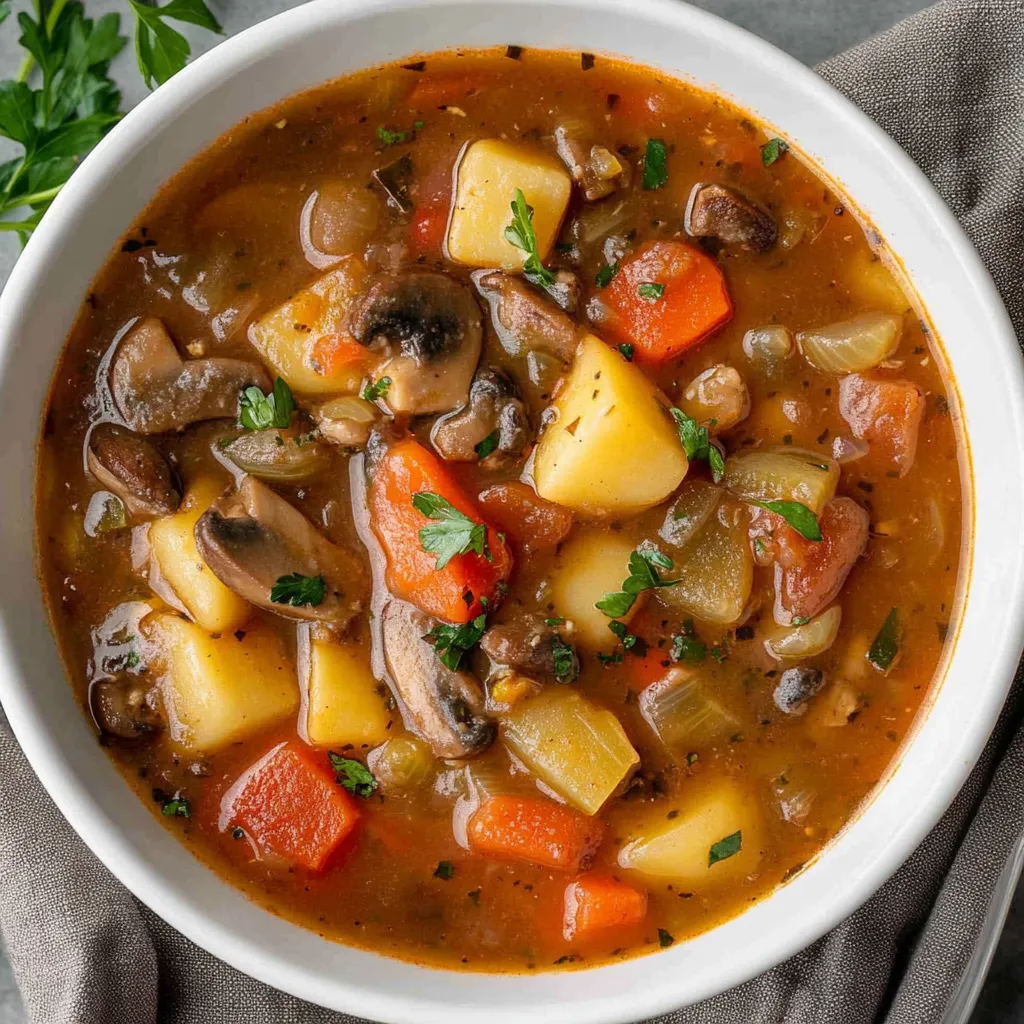 Pin it
Pin it
Throwing together whatever vegetables need using from the fridge with tomatoes and broth creates a hearty stew that warms you from the inside out. Mushrooms add meaty texture while potatoes, carrots, and celery provide substance that makes this feel like a complete meal despite having no meat. Fire-roasted tomatoes bring deeper flavor than regular canned tomatoes, and the whole thing simmers in one pot until everything is tender and the broth thickens into something rich and satisfying. This tastes like the kind of comfort food you'd order at a cozy restaurant but comes together with pantry staples and whatever vegetables are hanging around.
Vegetable stew became my solution for using up random vegetables before they went bad. I used to feel guilty throwing away wilted celery or carrots that had seen better days, but now they all go into the stew pot where they transform into something much better than the sum of their parts. The mushrooms specifically make a huge difference by adding richness that vegetable-only stews often lack. Fire-roasted tomatoes were a game-changer after trying them once and realizing their smoky depth beats regular canned tomatoes every time. Now I keep several cans in the pantry specifically for making this stew whenever the vegetable drawer gets too full.
Ingredients and Why They Matter
- Mushrooms: (1 pound, sliced) - Add meaty texture and umami flavor; cremini, button, or mixed varieties all work
- Yellow onion: (1 large, diced) - Aromatic base that sweetens during cooking
- Carrots: (3 medium, peeled and chopped) - Natural sweetness and color
- Celery: (3 stalks, chopped) - Classic stew vegetable that adds subtle flavor
- Garlic: (4 cloves, minced) - Essential savory depth
- Russet potatoes: (3 medium, peeled and cubed) - Starchy potatoes thicken the stew naturally as they cook
- Fresh thyme: (4-5 sprigs) - Earthy, slightly lemony flavor; dried thyme substitutes
- Tomato paste: (3 tablespoons) - Concentrated tomato flavor that adds depth
- All-purpose flour: (2 tablespoons) - Thickens the stew into proper consistency
- Fire-roasted crushed tomatoes: (1 can, 28 ounces) - Smoky depth; regular crushed tomatoes work but won't taste as rich
- Vegetable broth: (4 cups) - Base liquid; homemade tastes best but store-bought works fine
- Olive oil: (2 tablespoons) - For sautéing vegetables
- Salt and black pepper: (to taste) - Essential for proper seasoning
How To Make It
- Brown the mushrooms and onions:
- Heat the olive oil in a large Dutch oven or heavy pot over medium-high heat. Add the sliced mushrooms and diced onion. Don't stir immediately - let them sit for 2-3 minutes to develop some browning on the bottom. Then stir and continue cooking for another 8-10 minutes total, stirring occasionally. The mushrooms will release their liquid first, then that liquid will evaporate, and finally they'll start browning. The onions should become golden and soft. This initial browning creates the flavor foundation for your entire stew, so don't rush this step. The bottom of the pot will develop some browned bits stuck on - that's perfect and adds tremendous flavor later.
- Add aromatics and soften:
- Once the mushrooms and onions look nicely browned, add the chopped carrots and celery. Stir everything together and cook for about 5 minutes, stirring occasionally, until the carrots start softening around the edges. Add the minced garlic and fresh thyme sprigs. Season generously with salt and black pepper - about 1 teaspoon salt and ½ teaspoon pepper to start, knowing you'll adjust later. Cook for another minute until the garlic becomes fragrant and you can smell it clearly. This layered cooking technique develops more complex flavor than dumping everything in at once.
- Cook the tomato paste:
- Add the tomato paste directly to the vegetables in the pot. Stir constantly with a wooden spoon for about 2-3 minutes, making sure to scrape the bottom of the pot. The tomato paste will darken slightly and smell sweeter as it cooks. This step is crucial because raw tomato paste tastes metallic and harsh, but cooked tomato paste adds deep, sweet tomato flavor. Don't skip this even though it seems unnecessary - the difference in final flavor is significant.
- Create the roux:
- Sprinkle the flour over all the vegetables. Stir constantly for about 1-2 minutes, making sure every vegetable piece gets coated with flour. The flour will initially look dry and powdery, then gradually absorb the moisture from the vegetables and tomato paste. Continue stirring until you can't see any dry flour remaining. This flour coating will thicken your stew and give it body instead of being thin and watery. The flour also needs this dry cooking time to lose its raw taste.
- Add liquids and potatoes:
- Pour in the fire-roasted crushed tomatoes and vegetable broth. Use your wooden spoon to scrape up all those browned bits stuck to the pot bottom - this is called deglazing and captures incredible flavor. Stir everything together until the flour dissolves into the liquid with no lumps remaining. Bring the mixture to a boil over high heat. Once boiling, add the cubed potatoes and stir to submerge them in the liquid. Reduce heat to medium-low so the stew maintains a gentle simmer with just a few bubbles breaking the surface. Don't boil vigorously or the potatoes will break apart.
- Simmer until tender:
- Cover the pot with a lid slightly ajar to allow some steam to escape. Simmer for 25-30 minutes, stirring occasionally, until the potatoes are completely tender when pierced with a fork and the stew has thickened considerably. The potatoes will release starch as they cook, which naturally thickens the stew even more. If the stew seems too thick, add a splash more broth or water. If it's too thin, let it simmer uncovered for a few extra minutes to reduce. Taste and adjust seasoning with more salt and pepper as needed - stews always need more salt than you think. Remove the thyme sprigs before serving.
- Serve hot:
- Ladle the hot stew into bowls and serve immediately. The stew pairs beautifully with crusty bread for dipping, or serve over rice or quinoa for a heartier meal. A sprinkle of fresh parsley or a dollop of sour cream on top adds a nice finishing touch. Leftovers keep refrigerated for 4-5 days and taste even better after the flavors have melded overnight.
 Pin it
Pin it
Fire-roasted tomatoes became a pantry staple after comparing them side-by-side with regular canned tomatoes. The roasting process caramelizes the tomato sugars and adds subtle smokiness that regular tomatoes can't provide. They cost maybe fifty cents more per can but the flavor improvement is dramatic enough that I never buy regular anymore. My grocery store stocks them near the other canned tomatoes, usually in the same brand varieties. Once you taste the difference, you'll understand why recipes specifically call for them.
Mushroom Selection and Preparation
Different mushrooms create different flavors and textures in stew. White button mushrooms are most affordable and mild-flavored. Cremini (baby bella) mushrooms have deeper, earthier taste. Portobello mushrooms are mature creminis with even more intense flavor. Shiitake mushrooms add Asian-inspired notes. Mixed mushroom packages provide variety. Whatever type you choose, slice them uniformly so they cook evenly. Don't wash mushrooms under running water because they absorb moisture like sponges - wipe them with damp paper towels instead. The browning step concentrates their flavor and creates meat-like texture that makes vegetarian stews satisfying.
The Importance of Layered Seasoning
Adding salt and pepper at multiple stages throughout cooking builds more complex flavor than seasoning just once at the end. Salt added early helps vegetables release moisture and brown better. Salt added mid-cooking seasons the liquid as it reduces. Final seasoning adjusts everything to perfect balance. Each addition of salt enhances different components. This technique, called layered seasoning, is what separates home cooking from restaurant-quality food. Taste frequently as you cook and add salt gradually - you can always add more but can't remove it once added.
Flour as Thickener
Coating vegetables with flour before adding liquid creates a roux that thickens stew naturally. The flour needs dry cooking time to lose its raw taste and develop its thickening power. This method integrates the thickener throughout rather than adding a cornstarch slurry at the end. The result is smoother, more evenly thickened stew with better mouthfeel. Some recipes skip flour and rely on potato starch alone, but using both creates the most satisfying consistency. If you need gluten-free, substitute with cornstarch or arrowroot powder, though the technique changes slightly.
Fire-Roasted vs Regular Tomatoes
Fire-roasted tomatoes undergo charring over open flames before canning, which caramelizes their natural sugars and adds smoky depth. Regular canned tomatoes are just blanched and peeled with no additional flavor development. The difference becomes obvious in finished dishes - fire-roasted tomatoes create complexity that regular tomatoes can't match. If you can't find fire-roasted, regular crushed tomatoes work fine but consider adding a pinch of smoked paprika to approximate that smoky quality. The stew will still taste good, just slightly less interesting.
Vegetable Additions and Substitutions
The base recipe welcomes endless variations based on what needs using. Add diced zucchini or bell peppers with the carrots. Stir in leafy greens like spinach or kale during the last five minutes. Include a can of white beans or chickpeas for extra protein. Add frozen peas or corn at the end. Use sweet potatoes instead of regular potatoes for sweetness. Include parsnips or turnips for different flavors. Green beans add crunch. Each addition transforms the stew while keeping the basic technique identical.
Stew vs Soup
The main difference between stew and soup is liquid ratio and consistency. Soups have more broth relative to solids, making them spoonable but pourable. Stews have less liquid and more chunky ingredients, creating thick consistency that's eaten with a fork as much as a spoon. Stews simmer longer, allowing vegetables to release starch that naturally thickens everything. The flour roux in this recipe also contributes to stew consistency. You can adjust by adding more or less broth based on preference, though true stew should be thick enough that a spoon stands upright in it.
Storage and Meal Prep
Stew's ability to keep well makes it perfect for meal prep and batch cooking. Store cooled stew in airtight containers refrigerated for 4-5 days. The stew will thicken considerably as it sits because the potatoes continue absorbing liquid. Thin with broth or water when reheating. Freeze portions in freezer-safe containers for up to 3 months. Thaw overnight in the refrigerator before reheating. Some people prefer freezing stew without potatoes because they can become grainy, adding freshly cooked potatoes when reheating. Having containers of stew ready means dinner happens in minutes on busy nights.
 Pin it
Pin it
This vegetable stew represents the kind of cooking that turns humble ingredients into something genuinely satisfying without needing meat or complicated techniques. The combination of properly browned vegetables, fire-roasted tomatoes, and patient simmering creates comfort food that happens to be vegetarian rather than tasting like a compromise. When you serve a pot of this on a cold night and watch everyone go back for seconds without anyone mentioning the absence of meat, you know the recipe succeeds. Sometimes the best meals are the ones that prove vegetables can be just as hearty and filling as traditional meat-based dishes, and this stew definitely accomplishes that goal perfectly every single time you make it.
Frequently Asked Questions
- → Can I use different vegetables in this stew?
- Yes, this recipe is really flexible. You can swap in green beans, parsnips, turnips, or any vegetables you have in your fridge.
- → How do I make this stew gluten-free?
- Just replace the all-purpose flour with a gluten-free flour blend or cornstarch. Use about 3 tablespoons of cornstarch instead.
- → Can I freeze this vegetable stew?
- Absolutely. Let it cool completely, then store it in freezer-safe containers for up to 3 months. Thaw overnight in the fridge before reheating.
- → Why are my vegetables mushy?
- If you cut them too small or cook the stew too long, they'll get soft. Try cutting everything into bigger chunks and check the potatoes at 30 minutes.
- → Do I have to use a Dutch oven?
- No, any large heavy pot works fine. Just make sure it has a lid and is big enough to hold all the ingredients comfortably.
- → How can I make this stew thicker?
- Let it simmer a bit longer uncovered, or mash a few potato pieces against the side of the pot to release their starch into the broth.
- → What can I serve with this stew?
- Crusty bread is perfect for soaking up the broth. A simple green salad or some garlic bread on the side also works great.
